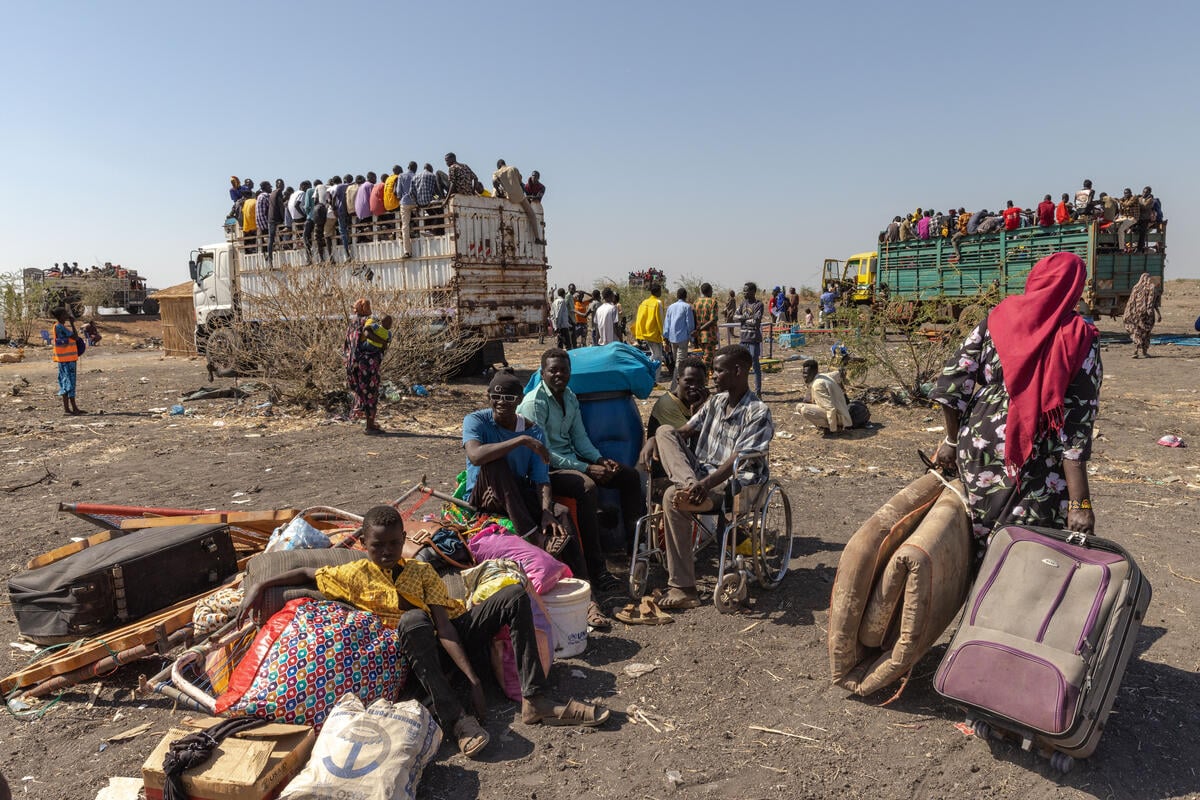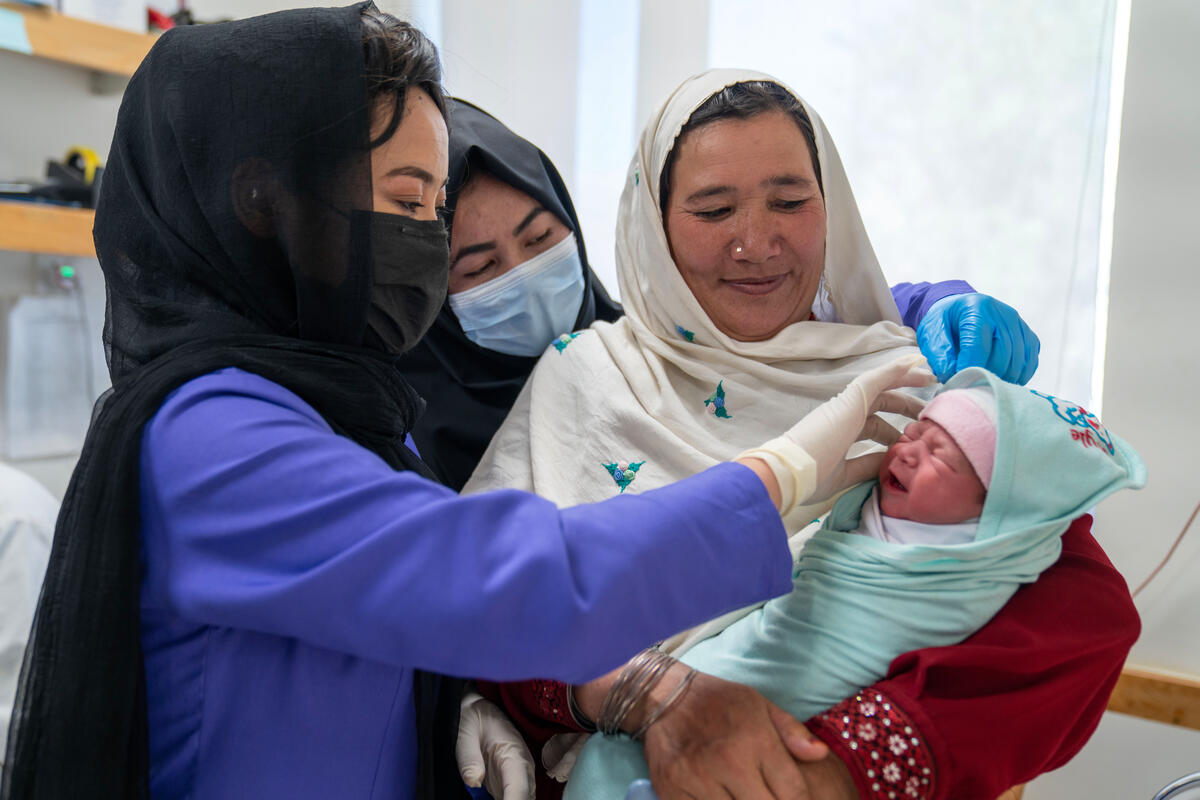Afghanistan Humanitarian Update No. 67
Afghanistan Humanitarian Update No. 67
Jan. 3, 2003
2002: Year of repatriation
Despite the fragile infrastructure and persistent security problems in parts of Afghanistan, more than 1.8 million refugees returned home in 2002, assisted by UNHCR and the Afghan Ministry of Refugees and Repatriation (MoRR). In addition, more than 250,000 internally displaced persons (IDPs) went home with assistance and another 200,000 Afghans returned on their own.
The UN refugee agency and the Afghan government initially planned to support the return of 1.2 million Afghans last year, including 800,000 refugees. But that target was surpassed only 15 weeks after the facilitated returns began on 1 March. Agencies then adjusted programmes to extend assistance to a total of 2 million returning Afghans through the end of 2002 in a repatriation and assistance operation UNHCR budgeted at more than $142 million.
The return rate has declined toward the winter months, with weekly returns of about 2,000 during December. This compared to a peak of over 100,000 a week in May. Since October, more refugees are returning from Iran than from Pakistan.
Monthly returns
| March | 122,000 |
| April | 298,000 |
| May | 413,000 |
| June | 292,000 |
| July | 303,000 |
| August | 197,000 |
| September | 107,000 |
| October | 49,000 |
| November | 15,000 |
| December | (as at 24 Dec.) 7,000 |
Countries of asylum (These figures are assisted returns.)
| Pakistan | 1,532,000 |
| Iran | 261,000 |
| Central Asia | 10,000 |
Despite the massive number of returns, some 4 million Afghans remain outside the country, including an estimated 2 million in Iran and 1.5 million in Pakistan.
Managing the return flow
Refugees requesting repatriation assistance under the Afghan government- / UNHCR-facilitated return programme are verified at Voluntary Repatriation Centres established throughout Pakistan and Iran.
In an effort to screen out Afghans who previously repatriated, or who appear intent on recycling back to an asylum country after receiving the small travel grant, the UN refugee agency utilises several screening mechanisms. The introduction in September of iris recognition technology in Pakistan to complement existing screening measures has proven to be quite effective in discouraging these "recyclers".
Upon arrival in Afghanistan, UNHCR provides transportation allowances ranging between $5 and $30 per person, depending on how far they have to travel to reach their homes. Returning families also receive an aid package containing plastic tarpaulins, soap and hygiene cloth, as well as 50 kgs of wheat flour from the UN World Food Programme. At the request of the Afghan government, which oversaw the repatriation effort, UNHCR targeted its assistance in rural areas in an effort to reduce the trend towards urbanisation.
Following the initial euphoria of returning to their homes, many Afghans faced the difficult challenge of re-establishing their lives in a country devastated by a quarter century of conflict and years of drought. Humanitarian agencies scrambled during the year to provide for the immediate needs of the returning families, especially in remote rural communities where UNHCR targets its assistance. But substantive reconstruction aid for infrastructure repair and employment is still urgently needed if returns are to be sustainable.
Despite the strong will of the Afghans to finally return to their homes, for UNHCR, the security and living conditions in Afghanistan are not yet sufficient to encourage all refugees to return at this time. Repatriation programmes aim to facilitate those refugees returning on their own to begin rebuilding their lives under difficult conditions.
Winter assistance
Having assisted the return of 2 million Afghans over 2002, the current challenge for the aid community is to help families get through the winter. The government and UNHCR estimate that some 550,000 people may face severe hardships during the cold season, including 290,000 recent returnees and 260,000 internally displaced Afghans.
Residents of villages in the central highlands are particularly vulnerable, as access routes will be cut off by snow. Other areas of concern include the southern region, where more than 400,000 displaced Afghans live in difficult conditions.
In preparation for winter, UNHCR stockpiled over 11,000 tents, 36,000 stoves, 146,000 blankets, some 70,000 plastic tarpaulins and 250,000 litres of kerosene. Another 50,000 stoves and 56,000 quilts are being produced through local employment projects and donors have been identified to purchase over 7,700 tons of charcoal and 2.5 million litres of kerosene. Other aid agencies are providing more food, clearing access roads and assisting the destitute among the general population, including those in cities.
The distribution of winter supplies has started in various districts throughout the country to help the most exposed families. In northern Afghanistan's Badakhshan, Jawzjan, Balkh, Kunduz and Sar-i-Pul provinces, winter supplies including stoves, blankets, plastic tarpaulins and tents for some families have already been distributed to some 3,000 needy families. About 3,500 families in the south got additional blankets; stoves and blankets have already been distributed to 14,000 families in Herat's IDPs camps and as well as to 3,200 families in four neighbouring provinces. ACTED, UNHCR's partner in coal distribution, has signed an agreement with the government for the mining of more than 11,500 metric tons of coal and distribution is underway.
Shelter and water projects
UNHCR directs its shelter aid to needy families returning to rural areas, where conditions are worse than in cities. In partnership with the Ministry of Urban Development and Housing, UN-HABITAT is responsible for shelter projects in urban areas.
The refugee agency's shelter programme that provided components (door, windows, timber, nails, hammer, shovel, door hinges and pick axe) for needy families to build 40,000 houses benefited more than 300,000 people in 2002, despite the logistical challenges in keeping up with the flow of returning refugees.
Over 2003, the refugee agency plans to distribute supplies for the rehabilitation 60,000 shelters in rural areas.
As agreed with the Afghan government, the provision of drinking water and shelter is the crucial first step toward helping families restart their lives in desolate villages.
Together with partner agencies, UNHCR helped rebuild 3,000 wells in return communities in 2002. In addition, more than 2,200 baths and 5,300 latrines have been constructed throughout the country and returnees were employed to repair canals and minor waterways.
Internally displaced Afghans
Throughout 2002, the UN refugee agency and government partners directed aid to villages to create conditions for the return of not only refugees but also IDPs. So far, UNHCR, the International Organization for Migration and other agencies have assisted over 250,000 displaced Afghans back to their home areas, while another 200,000 people have returned home on their own. But there are still some 700,000 IDPs throughout the country. The displacement problem is particularly acute in southern provinces, where an estimated 400,000 people are scattered after leaving their communities due mainly to the severe drought as well as ethnic tension in the north.
Regional breakdown of IDPs
| North | 51,000 |
| South | 413,000 |
| Centre | 124,000 |
| East | 70,000 |
| West | 66,000 |
| Estimated total | 724,000 |
Other problems in southern Afghanistan include IDPs encamped at Spin Boldak and a nearby group at Chaman in neighbouring Pakistan. In response to both governments' concerns about security, UNHCR agreed to relocate the displaced families to a new temporary settlement in Zhare Dasht, west of Kandahar, where they can be better assisted. Since the relocation began in August, nearly 5,000 families have voluntarily moved to this temporary site. But there are still some 30,000 people who insist on staying at the border because of the lack of job opportunities elsewhere.
With Afghan authorities, UNHCR is working to address the causes of displacement so that people can eventually return in safety. As a first step to allow the return of Pashtuns displaced from parts of northern Afghanistan since late 2001 due to their perceived affiliation with the Taliban regime and to encourage co-existence, the refugee agency has facilitated the creation of a Return Commission composed of northern leaders and the Afghan government to begin dealing with claims of abuses and other disputes.
There are many issues facing the displaced that cannot be solved by humanitarian agencies alone. Other UN agencies are looking at the problems of drought, especially in the south, so that displaced farmers can one day return to their land. Together with the Afghan government, the UN is also seeking solutions for nomadic Kuchis who lost their livestock and became aid dependent.
Bridging the gap
At the Afghanistan Support Group meeting in Oslo on 17 December, High Commissioner for Refugees Ruud Lubbers stressed the importance of security improvements and reconstruction assistance to help Afghan society absorb millions of returning refugees. Without the two, he warned, the success of 2002's massive repatriation efforts could quickly be reversed.
In line with its "4 Rs" concept of repatriation, reintegration, rehabilitation and reconstruction - the four key elements of any post-conflict recovery - the UN refugee agency continues to seek non-traditional ways to strengthen ties between humanitarian relief and longer-term development aid.
UNHCR has appointed senior staff to work directly with the Afghan government to help formulate coordinated policies between the Ministry of Refugees and Repatriation and the two development ministries: the Ministry of Reconstruction and Rural Development and the Ministry of Urban Planning.
UNHCR is also strengthening ties with development agencies such as the World Bank, UNDP and ILO. To support the reintegration of Afghans, UNHCR continues to lobby for the inclusion of returnee families and communities in the larger reconstruction and development schemes.
Helping the Afghan government build its own capacity is another crucial task for UN agencies. Over 2002, UNHCR spent nearly $ 2 million to help the Ministry of Refugees and Repatriation expand its reach and capacity through the provision of office equipment, vehicles and basic skills training. In addition, UNHCR's experienced Afghan staff have formed a task force to work directly with government offices and transfer their working knowledge in administration, programming, refugee protection, information and gender issues.
Returns from non-neighbouring countries
While the return of more than two million Afghans is a good sign for the future, both the government and UNHCR are concerned about the capacity of the war-torn country to absorb the sudden influx of millions of people. While for many Afghans the reasons for their exodus may have ceased to exist, there are still others who need continued international protection.
For those wishing to return to Afghanistan, the refugee agency asks host governments to provide support and ensure that returns are phased and coupled with development and reintegration support to increase the capacity in the communities of return.
To ensure that the returns are orderly and sustainable, the Afghan government and UNHCR have been discussing joint return programmes with governments hosting both Afghan refugees and migrants. During 2002, joint agreements were signed with Iran, France, the United Kingdom and the Kabul government, along with UNHCR. Another agreement is expected to be signed with Pakistan in early 2003.
Funding
UNHCR's regional budget for the Afghan repatriation and refugee assistance programmes during the 15 months ending in December 2002 was $271 million.
Over 2003, the refugee agency plans to assist 1.2 million refugees and another 300,000 IDPs to return to their homes. Under the Afghan government's 2003 Transitional Assistance Programme for Afghanistan (TAPA), UNHCR's budget for its Afghan repatriation and assistance programme is $127 million.
In Afghanistan, the UN refugee agency currently has 27 offices with more than 700 staffers, including 600 Afghans, overseen from a country headquarters in Kabul. Regional sub-offices are located in Kabul, Mazar-i-Sharif, Herat, Kandahar, Jalalabad and Gardez.
Over 2003, the refugee agency will spend another $35 million in Pakistan and $26.8 million for Iran, with a remaining $6 million for Afghan refugee programmes in the Central Asian states.








